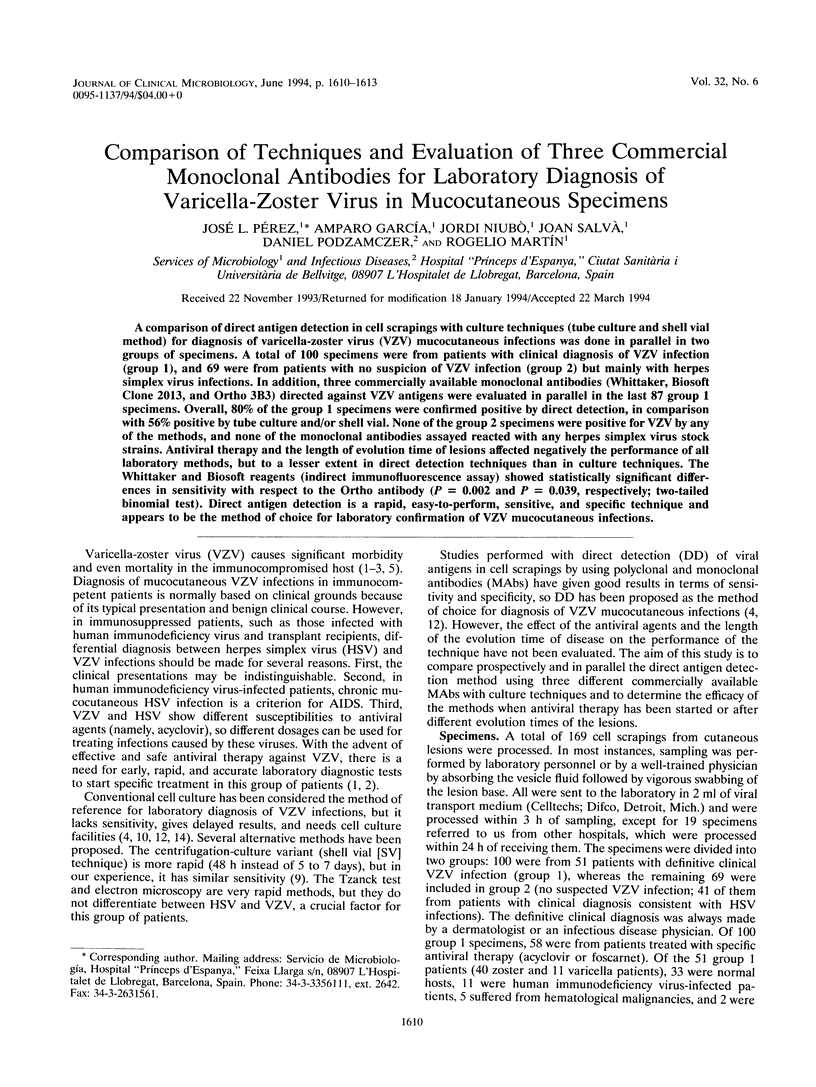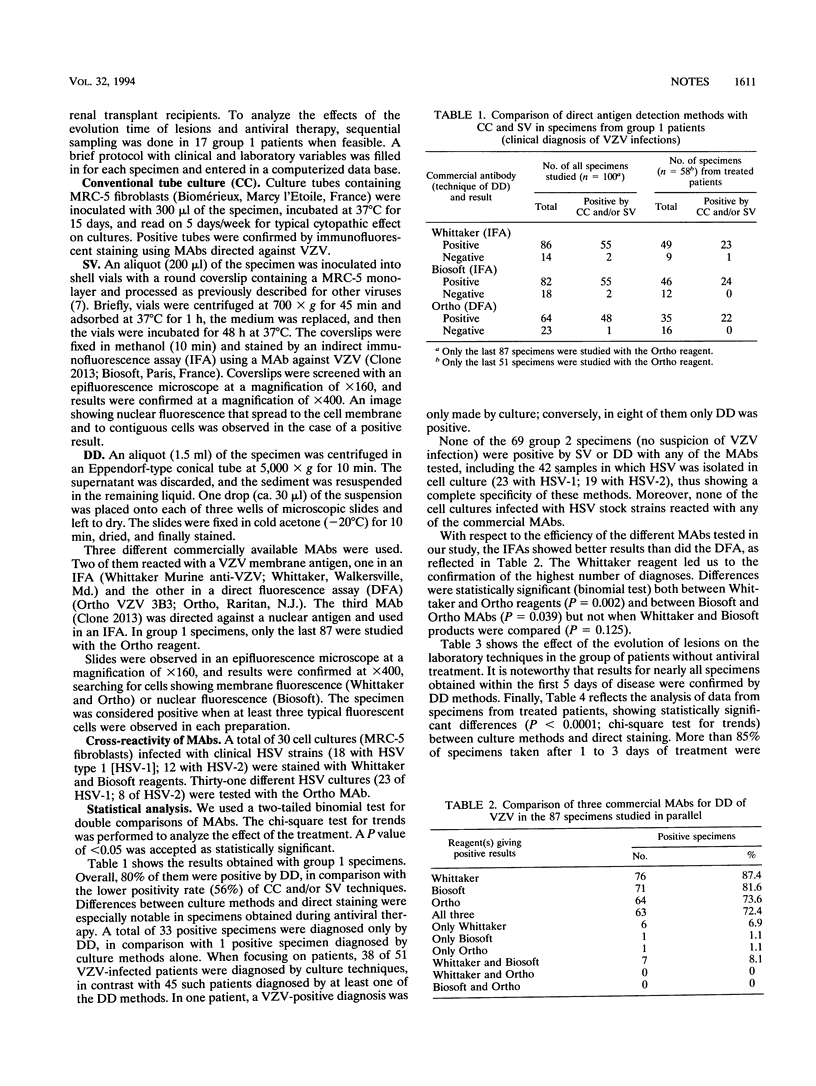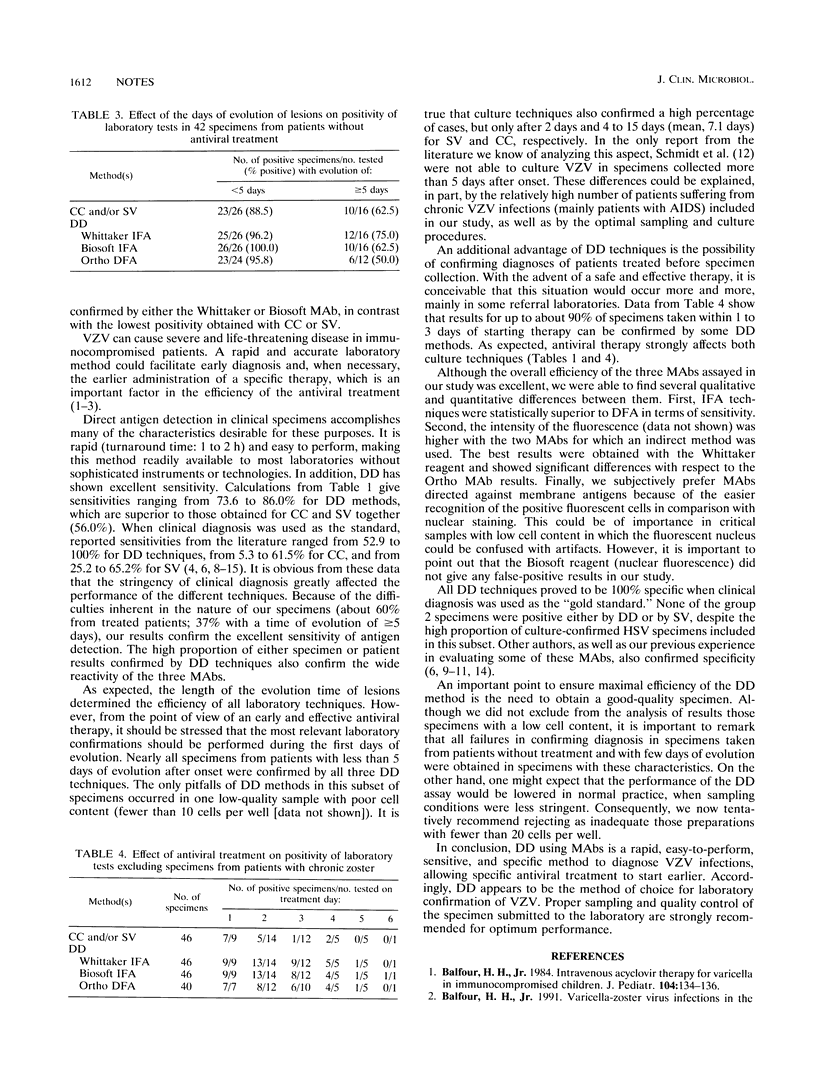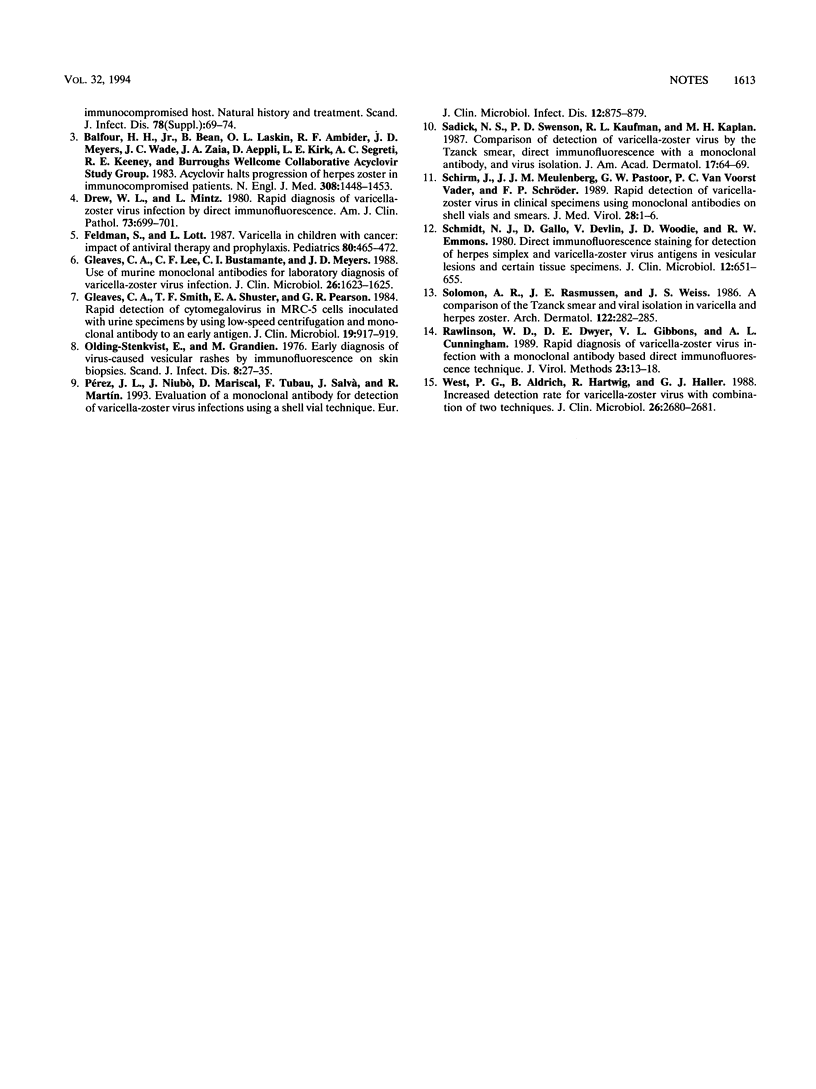Abstract
A comparison of direct antigen detection in cell scrapings with culture techniques (tube culture and shell vial method) for diagnosis of varicella-zoster virus (VZV) mucocutaneous infections was done in parallel in two groups of specimens. A total of 100 specimens were from patients with clinical diagnosis of VZV infection (group 1), and 69 were from patients with no suspicion of VZV infection (group 2) but mainly with herpes simplex virus infections. In addition, three commercially available monoclonal antibodies (Whittaker, Biosoft Clone 2013, and Ortho 3B3) directed against VZV antigens were evaluated in parallel in the last 87 group 1 specimens. Overall, 80% of the group 1 specimens were confirmed positive by direct detection, in comparison with 56% positive by tube culture and/or shell vial. None of the group 2 specimens were positive for VZV by any of the methods, and none of the monoclonal antibodies assayed reacted with any herpes simplex virus stock strains. Antiviral therapy and the length of evolution time of lesions affected negatively the performance of all laboratory methods, but to a lesser extent in direct detection techniques than in culture techniques. The Whittaker and Biosoft reagents (indirect immunofluorescence assay) showed statistically significant differences in sensitivity with respect to the Ortho antibody (P = 0.002 and P = 0.039, respectively; two-tailed binomial test). Direct antigen detection is a rapid, easy-to-perform, sensitive, and specific technique and appears to be the method of choice for laboratory confirmation of VZV mucocutaneous infections.
Full text
PDF



Selected References
These references are in PubMed. This may not be the complete list of references from this article.
- Balfour H. H., Jr, Bean B., Laskin O. L., Ambinder R. F., Meyers J. D., Wade J. C., Zaia J. A., Aeppli D., Kirk L. E., Segreti A. C. Acyclovir halts progression of herpes zoster in immunocompromised patients. N Engl J Med. 1983 Jun 16;308(24):1448–1453. doi: 10.1056/NEJM198306163082404. [DOI] [PubMed] [Google Scholar]
- Balfour H. H., Jr Intravenous acyclovir therapy for varicella in immunocompromised children. J Pediatr. 1984 Jan;104(1):134–136. doi: 10.1016/s0022-3476(84)80611-3. [DOI] [PubMed] [Google Scholar]
- Balfour H. H., Jr Varicella-zoster virus infections in the immunocompromised host. Natural history and treatment. Scand J Infect Dis Suppl. 1991;80:69–74. [PubMed] [Google Scholar]
- Drew W. L., Mintz L. Rapid diagnosis of varicella-zoster virus infection by direct immunofluorescence. Am J Clin Pathol. 1980 May;73(5):699–701. doi: 10.1093/ajcp/73.5.699. [DOI] [PubMed] [Google Scholar]
- Feldman S., Lott L. Varicella in children with cancer: impact of antiviral therapy and prophylaxis. Pediatrics. 1987 Oct;80(4):465–472. [PubMed] [Google Scholar]
- Gleaves C. A., Lee C. F., Bustamante C. I., Meyers J. D. Use of murine monoclonal antibodies for laboratory diagnosis of varicella-zoster virus infection. J Clin Microbiol. 1988 Sep;26(9):1623–1625. doi: 10.1128/jcm.26.9.1623-1625.1988. [DOI] [PMC free article] [PubMed] [Google Scholar]
- Gleaves C. A., Smith T. F., Shuster E. A., Pearson G. R. Rapid detection of cytomegalovirus in MRC-5 cells inoculated with urine specimens by using low-speed centrifugation and monoclonal antibody to an early antigen. J Clin Microbiol. 1984 Jun;19(6):917–919. doi: 10.1128/jcm.19.6.917-919.1984. [DOI] [PMC free article] [PubMed] [Google Scholar]
- Olding-Stenkvist E., Grandien M. Early diagnosis of virus-caused vesicular rashes by immunofluorescence on skin biopsies. I. Varicella, zoster and herpes simplex. Scand J Infect Dis. 1976;8(1):27–35. [PubMed] [Google Scholar]
- Pérez J. L., Niubò J., Mariscal D., Tubaú F., Salvà J., Martín R. Evaluation of a monoclonal antibody for detection of varicella-zoster virus infections using a shell vial technique. Eur J Clin Microbiol Infect Dis. 1993 Nov;12(11):875–879. doi: 10.1007/BF02000414. [DOI] [PubMed] [Google Scholar]
- Rawlinson W. D., Dwyer D. E., Gibbons V. L., Cunningham A. L. Rapid diagnosis of varicella-zoster virus infection with a monoclonal antibody based direct immunofluorescence technique. J Virol Methods. 1989 Jan;23(1):13–18. doi: 10.1016/0166-0934(89)90084-0. [DOI] [PubMed] [Google Scholar]
- Sadick N. S., Swenson P. D., Kaufman R. L., Kaplan M. H. Comparison of detection of varicella-zoster virus by the Tzanck smear, direct immunofluorescence with a monoclonal antibody, and virus isolation. J Am Acad Dermatol. 1987 Jul;17(1):64–69. doi: 10.1016/s0190-9622(87)70172-8. [DOI] [PubMed] [Google Scholar]
- Schmidt N. J., Gallo D., Devlin V., Woodie J. D., Emmons R. W. Direct immunofluorescence staining for detection of herpes simplex and varicella-zoster virus antigens in vesicular lesions and certain tissue specimens. J Clin Microbiol. 1980 Nov;12(5):651–655. doi: 10.1128/jcm.12.5.651-655.1980. [DOI] [PMC free article] [PubMed] [Google Scholar]
- Solomon A. R., Rasmussen J. E., Weiss J. S. A comparison of the Tzanck smear and viral isolation in varicella and herpes zoster. Arch Dermatol. 1986 Mar;122(3):282–285. [PubMed] [Google Scholar]
- West P. G., Aldrich B., Hartwig R., Haller G. J. Increased detection rate for varicella-zoster virus with combination of two techniques. J Clin Microbiol. 1988 Dec;26(12):2680–2681. doi: 10.1128/jcm.26.12.2680-2681.1988. [DOI] [PMC free article] [PubMed] [Google Scholar]


